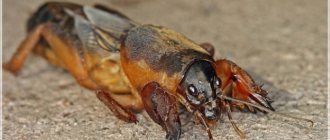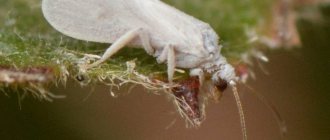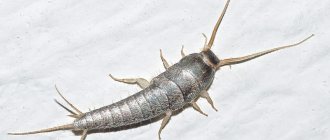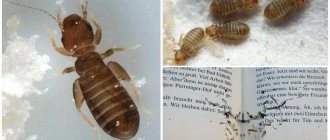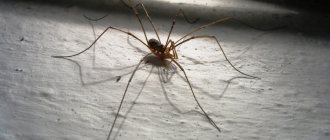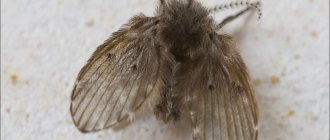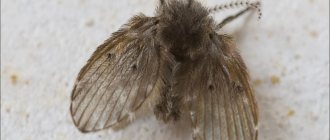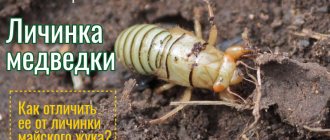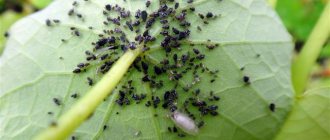The frightening and unusual appearance of the cabbage plant gives rise to fears and myths. They also say that it can bite a person, and that this bite is poisonous, although there is no poison in it (as well as useful substances - this is about the treatment of tuberculosis with dried insect powder), and it can scratch the skin only with the spikes of its front paws. The gnawing apparatus of the mole cricket is designed for eating roots, root crops, and succulent plant foods.
The powerful jaws and excavator paws of this insect attract the main attention, so few people look at the wings of the mole cricket. But she has them, and she uses them successfully, and in many ways. Long wings are used for flying through the air, and with the elytra the top produces a characteristic cricketing and chirping sound - this is how sexually mature adults look for a life partner.
Signs of a mole cricket on the site
Even attentive gardeners often do not notice that mole crickets have appeared on the site. Meanwhile, pests leave obvious traces of their presence.
What signs indicate that there are mole crickets in the area:
- unexpected death of plantings;
- drying of young growth, which is easily removed from the soil;
- formation of rhizome damage in adult plants;
- holes on roots and fruits;
- the appearance of holes with a diameter of up to 2 cm near the plants with passages leading from them;
- detection of small earthen mounds and open holes with clearly defined edges. If you pry the ground with a shovel in this place, you may come across a mole cricket nest.
- in May–June (mating season) they begin to chirp, attracting females. The louder the male is, the more females come running to him. By chirping, gardeners judge the appearance of harmful insects.
Soon after the first signs appear, the pests crawl out. Mole crickets lead a closed lifestyle, but in search of food they come out of their burrows.
Harm
The main danger is the destruction of the crop. Having appeared on the site in single copies, the mole cricket reproduces very quickly. Numerous hordes quickly destroy the harvest of root crops: potatoes, radishes, radishes, carrots, and beets. They do not disdain the young roots of planted seedlings of tomatoes, cabbage, onions and cucumbers lying on the surface of the ground.
It causes great harm to shrubs, eating up plant roots, as well as bulbous plants (tulips, lilies, gladioli, etc.), strawberries, watermelons, melons. The voracious bug feeds not only on plant foods; it also uses earthworms, larvae, and small insects.
It is easy to notice the appearance of insects in the garden. Making their tunnels underground, mounds of earth are visible on the surface of the soil. The pest is especially active in the spring, when the earth warms up. That is why gardeners perceive this insect as their worst enemy. You will have to put in a lot of effort and time to get rid of it forever.
Causes of pests
There are several reasons for the appearance of pests on an existing site. Each is explained by the way of life of insects.
Reasons for appearance:
- In well-kept areas with fertile soil you can always find delicious food.
- In loose, fertilized soil it is easier to make passages and dig holes.
- They are attracted to dung heaps, where it is warm and satisfying. It’s good to spend the winter in them without worrying about food.
Therefore, although mole crickets do well in abandoned dachas, wastelands, and weed thickets, they prefer well-groomed areas with fertile soil.
Habitats
These insects live over a wide geographic range, almost everywhere in Eurasia (with the exception of the northern Scandinavian countries), North Africa, the Americas, and Australia. They are not found only in
Antarctica northern arctic regions.
As a habitat, mole crickets most like wet places: meadows, floodplains. They usually live in underground passages and are often found near irrigation canals and in wetlands.
What crops are affected by the pest?
The mole cricket is an omnivorous insect. Damages above-ground and underground parts of crops. The exception is the roots of trees and shrubs. Destroys tubers and sown seeds, seedlings of berry and ornamental plants, vegetables, fruits and berries.
The following crops are often affected:
- young potatoes;
- White cabbage;
- radish;
- fodder and sugar beets;
- beans;
- carrot;
- tomatoes;
- radish;
- pumpkin;
- Bulgarian pepper;
- eggplant;
- parsley;
- melon crops.
Among the berries, strawberries, wild strawberries, and grapes are preferred. Fallen ripe fruits of pear, apple and plum trees also attract the attention of the mole cricket. The pest affects wheat, rye, barley and other grain crops. In forest areas, young spruce, pine, and oak trees are attacked.
Natural enemies
Of course, the mole cricket has its own enemies in natural conditions, among them rooks, starlings, crows,
hedgehogs, lizards, moles, ants (they pose a threat to mole cricket larvae). Also among pets, the enemy of this insect harmful to the garden is the cat, which can hunt and eat mole crickets like mice and rats, which is of great benefit to the household.
Preventive measures
Even if mole crickets are not visible on the site, there is no guarantee that they will not appear in the near future. Pests come from a neighboring garden, appear on the site along with manure, fly through the air, and in other ways. Simple preventive measures will help preserve the harvest.
Preventive measures:
- When selecting fertilizers, fresh manure is excluded. The best choice is biennial manure. Then the appearance of pests will become impossible.
- Everyone knows the role of green manure in plant cultivation. These are not only green fertilizers. Green manure protects cultivated plants from insects. Therefore, it is useful to plant them to preserve the harvest. It is better to plant rye or marigolds against mole crickets.
- If the autumn garden is not put in order, plant remains are not burned or buried, mole crickets and larvae choose old fruits and leaves for wintering. And in the spring they fill the area. Therefore, autumn work in the garden is protection from mole crickets.
- Agrotechnical activities, such as weeding and digging, play an important role in the battle with mole crickets for the harvest. By pulling out weeds, a person deprives the mole cricket of food. In addition, mole crickets do not return to the ground where tunnels and burrows have been destroyed by digging.
- Crop rotation prevents diseases and the spread of pests. Planting plants constantly in one place provokes the accumulation of old diseases, and at the same time mole cricket larvae.
- Mole crickets settle only in acidic soils. Therefore, annual soil deoxidation reduces the likelihood of site contamination. For deoxidation, use lime or dolomite flour.
- Since the mole cricket loves warm soil, gardeners reduce the soil temperature. To do this, mulch the soil with light material. Straw, sawdust, pine needles will do. In addition to lowering the temperature, the smell of mulch also repels the pest.
For prevention purposes, garden crops are planted near the beds or along the perimeter, which repel the pest with a specific smell. And experienced gardeners do not recommend fresh manure, where larvae and adult insects settle. It is recommended to use humus or compost.
Chemical control
The chemical industry produces many insecticidal preparations that successfully combat
bear:
- "Medvetox";
- "Medvecid";
- "Boverin";
- "Rembek";
- "Phenaxin Plus"
As a rule, it is enough to add the recommended amount to the soil during autumn and spring digging, or directly into the holes. Experienced gardeners, when adding this “delicacy” to the bear, flavor it with vegetable oil so that the smell attracts insects.
The dosage and method of use of the drugs are always described on the manufacturer’s packaging. It is imperative to comply with these requirements, since if you save on money, you can skip the spring wrestling season. As a result, the mole cricket will get another year, during which it will breed huge offspring.
Despite its terrible appearance and ability to quickly multiply and spread, the systematic and methodical destruction and scaring away of this monster insect will clear the area of it and get an excellent harvest.
If you read this article to the end, you may have found it helpful. Share the information with your friends and like-minded people, and they will thank you. Join our groups on social networks, write comments, help make the project even more interesting!
How to get rid of a mole cricket
If prevention does not produce results and mole crickets settle on the site, traditional methods of control are used. If the remedies don’t help, move on to chemistry.
16 folk remedies for mole crickets
The advantage of the methods is that they contain substances that are safe for both humans and plants.
Description of funds:
- Soap solution. Combine the liquid with soap shavings, add vegetable oil in a ratio of 1:10. A liter of liquid is poured into the mink. Soon a mole cricket will appear on the surface. All that remains is to catch and crush the pest.
- Eggshell. The dried eggshells are crushed. Add vegetable oil with flavor. Treats are placed in the planting holes or grooves. Then seedlings or seeds are planted. Mole crickets will not resist such a snack, but sharp pieces of shell will be destructive for them. The remaining shells will turn into fertilizer.
- Oil solution. Water is poured into the mink, 1-2 tbsp is introduced. l. oil, then water again. Making its way to the exit, the pest swallows a viscous composition that atrophies the respiratory tract. The body of an already dead insect will appear on the surface.
- Bread and matches. A piece of crustless bread is moistened with water and kneaded until sticky. Rolling balls. Match heads are inserted inside the balls, where the soaked sulfur contaminates the bread bait. All that remains is to scatter the balls around the area and next to the mink, then wait for the result.
- Ammonia. Dilute 3 tbsp in 10 liters of water. l. ammonia. Water the soil, being careful not to get it on the plants. The smell of ammonia will force mole crickets to look for a new shelter. When preparing the poison, the proportions are observed so as not to oversaturate the soil with nitrogen.
- Iodine. The beds with root crops are watered with iodine solution. 15 drops of the drug are diluted in a 10-liter bucket of water. The smell causes insects to scatter and never return. This product is used to treat greenhouses and open areas.
- Kerosene in water. 150 g of kerosene are diluted in 10 liters of water. Pour the composition into holes and passages. As a result, the mole cricket's instant death follows.
- Kerosene with sand. A bucket of sand is mixed with a tablespoon of kerosene. Scattered in the garden along the paths. Sprinkle the beds and the ground around the holes.
- Onion peel. Pour 800 g of husk into a 10-liter bucket of hot water (not boiling water). The composition is sprayed over the area, not leaving unattended areas where pests accumulate. Or leave a bucket of solution on the site. In both cases, the onion aroma will force the bear to leave the territory.
- Garlic. Chopped or crushed garlic is placed in the seed holes. The pungent smell will repel pests.
- Chicken droppings. To prepare the product, add 2 kg of chicken manure to a bucket of water and leave for 24 hours. Add water to the resulting mixture at a ratio of 1:5 and water the beds.
- Manure. In the fall, they dig a hole near the garden, with a length, width and height of 50 cm, then fill it with manure. Mole crickets will certainly settle in manure for the winter. When frosts occur below -3°C, a hole is dug out and manure is scattered around the area. Pests freeze and die.
- Jars with liquid. At the beginning of the spring season, holes are made near the beds into which jars of water, kvass or beer are placed. The neck of the jar is left at ground level. At night, mole crickets accumulate there.
- A piece of iron. The method is used in the spring, before digging up the site. Although the method works in summer too. On a sunny day, small pieces of iron are scattered around the area. Under them, mole crickets accumulate, having come out to bask. At this point you can get rid of pests.
- Barrier planting method. Gardeners have figured out how to protect flower bulbs from mole crickets. Plants are planted in cut bottles, which are buried 15 cm into the ground. 2–3 cm are left above the soil surface. The path to the bulbs is closed to pests.
- Protective rings. Trenches 20–50 cm deep are dug around greenhouses or beds. Crushed shells, ash, sawdust, broken glass, and fragments of bricks are poured into them. Spray kerosene on top. This prevents access for pests.
Cruciferous flea beetle in the garden: 4 safe ways to control the pest
Publicly available means in the fight against mole crickets will give results if neighbors in the garden get involved. Otherwise, it will not be possible to remove the mole cricket.
8 chemical treatments for mole crickets
There are quite a lot of chemicals, and some help in the fight against mole crickets and other pests.
Effective chemistry against mole crickets:
- Medvetox. Available in granular form. The drug is non-toxic and does not harm soil microflora. The granules are buried 3-5 cm in the grooves between the beds. After 4 hours the drug begins to act. Protects against pests for 14 days.
- Anti-Medvedka. The drug is insecticidal. Release form: microgranules. Protects vegetables and flowers from mole crickets and other insects. When planting and sowing crops, granules are scattered between the beds.
- Medvecide. Powerful bait for killing various types of insects. Harmless to people and animals. Available in granule form. The beards, 2.5-3 cm deep, are dug at a distance of 0.8-1.0 m from each other. Each one contains 5 to 10 granules. The bait is valid for 20 days.
- Rembek. Granular insecticide with a pungent odor. Does not pose a threat to the environment. The bait is distributed among minks and dug passages. One 360 g packet of product is enough to treat 15 acres of land.
- Phenaxin plus. Available in the form of granules with a smell that attracts mole crickets. But the main danger is the neuroparalytic effect that the drug has. The bait is scattered on the beds, around trees, in manure and other fertilizers. One pack of granules is enough for 10 square meters. m area. The product is valid for 20 days.
- Calcium carbide. The product is used to fill minks, holes, and passages. After rain or watering, a chemical reaction begins, releasing toxic gas. None of the pests will be saved.
- Bio-discharge. A broad-spectrum drug. The insecticide is available in powder form and is used diluted. The product package is diluted in 10 liters of water. Use 0.5-1.0 liters of solution per well. The product attracts mole crickets as it releases an odorous substance. And then it neutralizes it. It is possible to add dry product into the hole.
- Grizzly. Attracts insects by smell. Destroys at any stage of development. Fill the holes along the bed with granules and sprinkle with soil. Plants will be protected for up to three weeks.
Aphids on roses: 7 effective methods to combat them
Chemicals are used with caution. Among them there are toxic ones or those that are prohibited from being used in conjunction with other products.
3 biological remedies for mole crickets
Experienced gardeners see biological products as an alternative to chemicals.
Since beneficial insects live in the garden, you need to choose biological products with care so as not to cause harm. And at the same time, protect the area from the presence of the mole cricket.
Popular biological products:
- "Boverin". The product contains fungal spores. Penetrating into the body of the mole cricket, the spores germinate and ultimately cause death. The product is more effective in controlling greenhouse pests.
- "Nemabact." Contains bacteria and predatory nematodes. The drug infects the insect with bacteria, due to which the insides decompose and the pest dies. The drug is effective, but capricious. If storage conditions are not met, it loses its properties. Stored in the refrigerator. Effective in garden beds at temperatures up to 25°C.
- "Anthony F." The drug has the same range of action as Nemabact. Differs in the type of nematode.
If the production technology of biological products is violated and the shelf life has expired, quality is lost.
Agrotechnical measures
Carrying out agricultural work is unlikely to help completely eradicate the mole cricket. But when carried out in combination with other methods, extermination of the pest is possible.
Tips and tricks
After collecting the last harvest, put the area in order. Clear away debris, leaves, and branches. Cleaning will allow you to notice pests and their holes.
Dig up the area with a spade twice, in the fall and in the spring. It will be possible to destroy burrows and nests. And catch the scattering mole crickets with traps.
Treat seed and roots of seedlings before planting. Inspect the soil from time to time, remove weeds, and carry out preventive measures.
Traps
Having studied the taste and aromatic preferences of the cabbage moth, gardeners have developed traps for the mole cricket. Some of them are interesting.
Dung
The mole cricket is attracted by the smell of manure. Gardeners lay out piles around the site. Very often pests settle in them and lay eggs here.
Glass
A liter jar is filled with honey, mashed potatoes or sunflower oil. Buried vertically in the ground in places where there are a lot of pests. I cover the jar with straw, leaves, and dry branches. A mole cricket that has fallen into a trap is unlikely to be able to get out.
Honey
It is good to set such traps in late summer - early autumn. During this period, pests are preoccupied with preparing for winter.
The jar coated with honey is covered with a sheet of plywood or tin and insulated on all sides with straw. Cabbage damsels happily climb into the fragrant, warm, but deadly trap.
Beer houses
Since cabbage plants like malt, gardeners bury an open bottle of beer in the ground. Place the container at an angle to make it easier for the bear to get inside.
Ultrasonic devices
Previously, these devices used to scare away rodents, but, as it turned out later, some successfully deal with mole crickets. These are “Antikrot”, “Tornado” and “Ecosniper”.
To achieve the effect, one device per area is not enough. It was calculated that at least one device will be required per 1 are (one hundred square meters). Externally, the device resembles a capsule that is stuck into the ground.
There are about 15 varieties of ultrasonic devices. They differ in name, price, range, duration of operation. Each device comes with an instruction manual.
Natural enemies
When fighting a mole cricket, one should not forget that humans have natural helpers in this difficult task.
Natural enemies of mole crickets:
- birds (rooks, crows, starlings, herons, etc.):
- ants and ground beetles;
- insectivores (hedgehogs, lizards, moles);
- cats;
- fungi;
- Larra anathema wasp.
These representatives of the living world cope well with pests, eating them at every opportunity. Gardeners should attract birds and hedgehogs, ground beetles and cats to their plots. But unfortunately, some natural helpers are rarely found in nature (Larra wasp), others cause no less trouble than mole crickets (ants, moles, etc.).
Biological methods
The mole cricket has many natural enemies. First of all, these are birds. The greatest damage to the population is caused by rooks, crows, starlings and even ordinary chickens.
Hoopoe catching a mole cricket
It is recommended to let the latter out into the garden from time to time. Naturally, this needs to be done at a time when the chickens themselves cannot harm the crops; for example, before the beginning of periods of active growth of young plants, fruiting, harvesting, etc. Chickens are able to perfectly find mole crickets and their larvae and destroy them.
In addition, hedgehogs, lizards, shrews, moles and ants are involved in the destruction of mole crickets. Attracting, for example, a hedgehog to your garden is very simple - just place a saucer of milk in the garden every evening.
With birds, everything is also relatively simple - birdhouses or nest boxes on the site will significantly improve the situation with any harmful insects, including mole crickets.
There is also a highly specialized enemy of the mole cricket – the Larra anathema wasp. This type of wasp lays eggs exclusively in mole crickets, where their development occurs. After the larva matures, it leaves the host, who soon dies.
Larra anathema wasp, a natural enemy of the mole cricket
This insect does not pose any harm to humans, plants and other inhabitants of the garden, therefore, if you encounter this wasp, there is no need to destroy it. The wasp is quite widespread in the south of the European part of Russia, in the Krasnodar Territory, as well as in Ukraine, Moldova, and Georgia.
If the issue of counteracting mole crickets is very pressing, you can also try to use wasps to combat them. Legumes are used to attract wasps. larra” is best attracted to a plant called “partridge pea”.
Is there any benefit
Despite the dislike of mole crickets for damaging the crop, gardeners note one positive aspect from the presence of insects on the site. By making moves, mole crickets help enrich the soil with oxygen, which roots and microorganisms need.
Fishermen use pests as bait when fishing for catfish, burbot, barbel, and ide. And citizens of Asian countries eat, prepare delicacies and seasonings, fry, marinate and stew.
But the beneficial properties are not comparable to the harm that the pest causes to plants and crops.
Description
For someone who doesn’t know what a bear looks like, the description may conjure up a scary monster. Considering the amount of damage it can cause, perhaps it is so. The mole cricket belongs to a group of insects, the order Orthoptera. It is not difficult to recognize it in nature - the head is similar to the head of a crayfish, the forelimbs are developed, only instead of claws, the mole cricket has powerful digging organs. The average size of the insect is about five centimeters, but there are individuals the size of the palm of an adult.
Medvedka photo
The front pair of legs of an insect is adapted for digging the ground. The middle ones allow you to run quite quickly. The hind legs are similar to the legs of grasshoppers, but they are not so developed, so the mole cricket, although it jumps, is very low.
Despite the presence of wings, the mole cricket rarely flies, at low altitude, and only if the air temperature is high enough. During cold periods, the insect cannot fly because the wing muscles are weak. A sudden danger, the call of a male, or the need to change its habitat can force the cabbage to fly.
The mole cricket's jaws can gnaw through hard root crops, but the real delicacy for it is the juicy roots of young plants. Several mole crickets can cause significant damage to the crop over the course of a season.
But the biggest danger of these insects lies in their mobility and fertility. Under favorable conditions, mole crickets easily fly over long distances, and as a result, two individuals settling on a site can breed so many offspring that the garden can become a barren desert. The mole cricket reproduces by laying a large number of eggs. From them emerge larvae that can live and develop for several years. From one pair, 200-500 individuals are hatched, and if they are not destroyed in time, they will first feed on the roots of young plants, and then begin to eat root crops. Some of the bear's favorite dishes are potatoes and beets.
Is it dangerous for humans?
Seeing a mole cricket, everyone will be afraid of how unattractive she is. But the pest is not poisonous and does not pose a danger to humans. Some gardeners claim that these insects bite. But even adults can only pinch lightly with their front paws. Sometimes the bite is painful, but this sensation quickly passes without a trace.
Although the mole cricket is not poisonous, it does a lot of harm due to its lifestyle. This insect is dangerous to plants and crops. But there are many ways to get rid of it, and any gardener will always choose the one that is suitable in each individual case. And if events are held in a complex, and even together with neighbors, the pest is forgotten forever.
Ultrasonic repellers
A modern universal way to combat garden pests is ultrasonic repellers. These products will save your area not only from mole crickets, but also from moles, rats, and shrews. The device emits signals that are not audible to the human ear, but are completely intolerable to pests. The constant broadcast of unpleasant sounds forces mole crickets to leave your area.
However, gardeners have ambivalent assessments of such means. It is enough to turn off the device, and the area again becomes defenseless against pests. Moreover, some insects “get used” to ultrasound, and it ceases to be an obstacle to crop destruction.
ultrasonic repellers against garden pests
Interesting Facts
- Gourmets in South-East Asia sometimes consume these insects as a delicacy. Moreover, they are prepared fried, stewed, pickled, with the addition of seasonings or even without them.
- Sometimes the mole cricket brings some benefit, as it destroys the larvae of cockchafers and some other insects that eat plants
- Surprisingly enough, there are benefits from Medvedka in the field of pharmaceuticals as well. So a powder is made from it, which is used as one of the components for a cure for tuberculosis.
Types, photos and names
Different types of mole crickets practically do not differ from each other, neither in appearance, nor in habits and way of life. They can be distinguished biologically only by the number
chromosomes. Next, we will describe in detail some common types of mole crickets.
Mole cricket
In fact, this is the most common species among these insects. Widely distributed in Europe (with the exception of Scandinavia), lives in a number of Asian countries and northern Africa. Almost everything that we describe here about mole crickets, first of all, concerns the common mole cricket.
African mole cricket
It is slightly smaller in size than the common mole cricket, the body length is 2.5-3.5 cm. It has a brown-yellow body color. Lives in the African tropics and subtropics, but in addition to the “Black
continent" is also found in Southeast Asia and even on the Japanese islands.
Ten-toed mole cricket
This species is distinguished by its small size - from 1.9 to 3 cm. It inhabits both Americas, and it is believed that initially they were found only in North America, but gradually penetrated into South America.
Steppe mole cricket
In appearance it is an exact double of the common mole cricket. This species prefers steppe terrain as a habitat; it lives in the steppe belt of our country, Ukraine, southern Russia, Kazakhstan, Turkmenistan and a number of other Middle Eastern countries.
What doesn't he like?
Trying to remove mole crickets, gardeners tear up their underground passages and pour poisons or washing powder into them. In the same way, you can scare away mole crickets by scattering a pincushion made of pine needles around the garden plot.
Also, as a remedy against mole crickets, they use bait made from boiled corn , barley or wheat, adding a little sunflower oil and even more insecticide.
Making a fishing pit: in the fall, manure is poured into a pit 60-80 cm deep, and in winter it is thrown out and the pests found are destroyed.
If you need to protect the garden plants themselves , cut small pieces of natural fabric 20 by 10 cm, moisten with water and tie the base of the stems before planting them in the ground.
The smell of chicken droppings is also extremely unpleasant for mole crickets. To do this, you need to make a water infusion with droppings and periodically water the plants with it.
You can sow areas with rye as green manure , although there may not be room left for the rest of the crop.
Every few meters, stick green alder branches into the ground, and do not forget to replace them occasionally with new ones.
